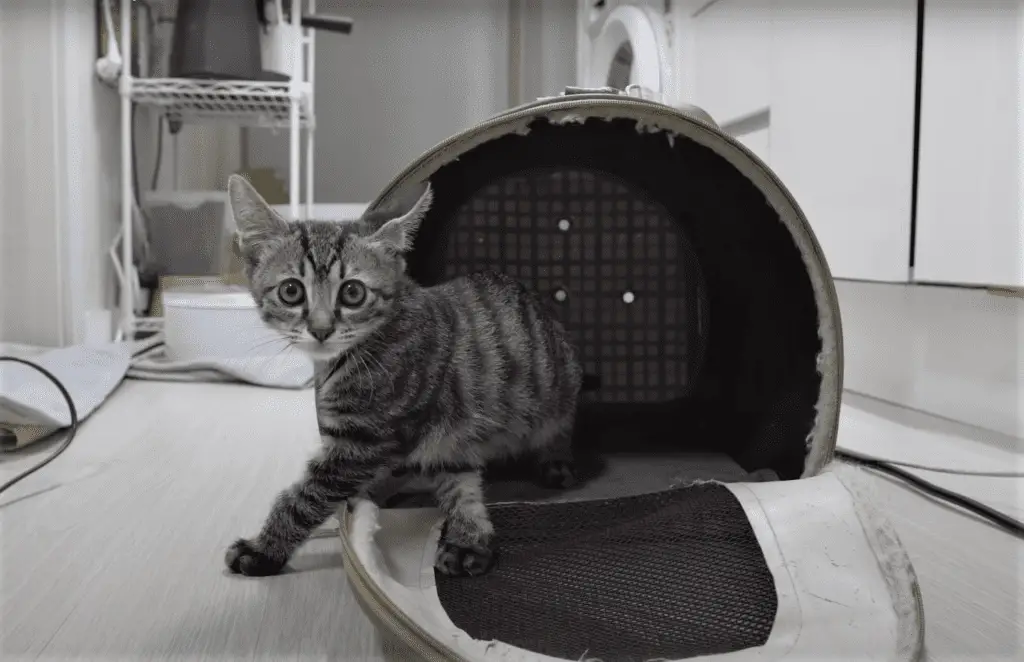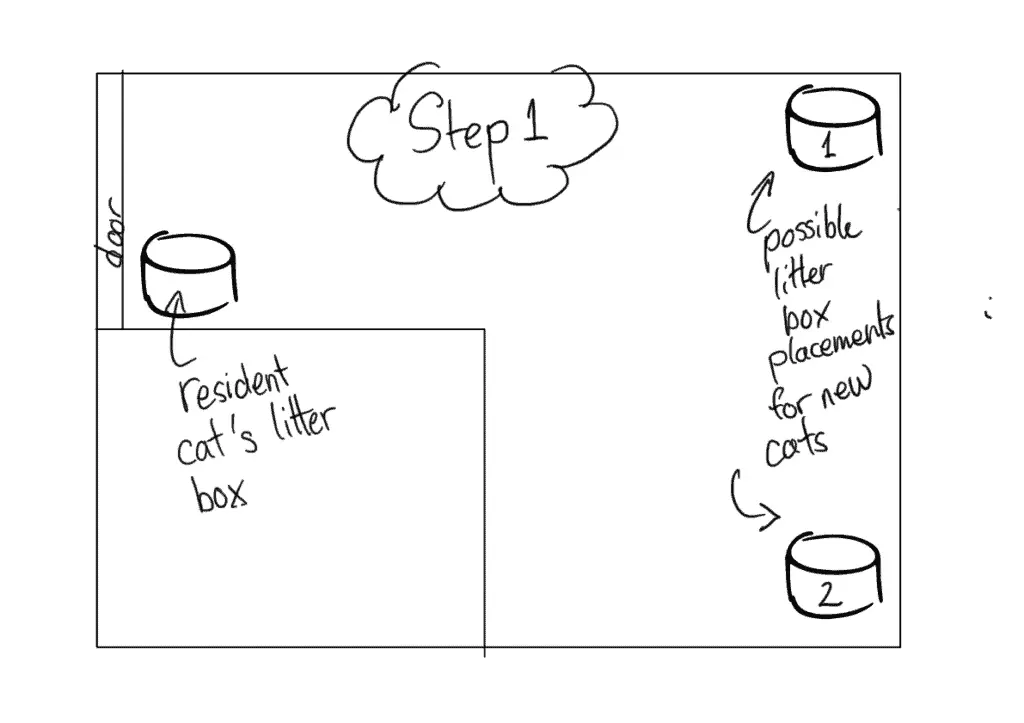The regular protocol for cat introductions is pretty exhausting and sometimes isolating our cats is not possible. To be honest you don’t have to do all of that and I have done it without.

I have written an article about this before but I want to do a more step-by-step guide about how to go about the cat-to-cat introduction process in a one-room apartment, studio apartment, or even introducing new cats in one room of your house. This will include pictures and have some recommendations of what products I will recommend for this.
These are the strategies I use and have streamlined new cat introduction without isolation into very easily followed steps. This introduction process will take about 3-5 days for the cats to be accustomed to each other, provided that the cats are healthy, neutered/spayed (if they are adult cats), and don’t have any previous history of being aggressive (see more in the next section).
Additionally, along with this article, I have expanded on the whole process with a comprehensive guide taking you through the methods and tips on how to ensure the best chances of success: Comprehensive Guide on Cat Introductions (Slowest to Quickest Methods).
To help you guys on your quest for cat’s happiness, this pdf will help track your cat’s progress and see where you need to push their boundaries. Share with me how long your introduction process takes down in the comments!
Before Starting The Introduction Process
Again, I have written an extensive article on how to make the introduction process a lot easier. It would help to read that and see if the new kitten or cat is a good fit for your home.
So before bringing the cat into your home, this is the checklist to make sure everything is ready before the introduction process takes place.
- One extra temporary litter box (can just be a box) appropriate to the cat being introduced. If it’s a kitten, then a lower litter box is required. When the cats are accustomed to each other, you can remove it.
- Resident cat(s) are healthy and if they are adults, they need to be neutered or spayed.
- New cat(s) are healthy and again, if they are adult cats they also need to be neutered or spayed.
- Stop free-feeding the cats, we need to be able to use their hunger as a tool for the introduction process.
- An interactive toy such as a wand tool or a laser.
Kittens under 6 months of age don’t have to be neutered/spayed but if they are already, that’s okay. The reason I make sure that the new cat is either very young or spayed/neutered is that if they’re not, the hormones wreak havoc on the introduction process.
An intact adult male cat is severely territorial and is more prone to be aggressive to any new cat that will be introduced. An intact adult female is also very unpredictable in their behaviors. So it’s best to make sure that this isn’t one of the reasons that they aren’t getting along, because, if it is, it will be very hard to fix.
Step 1: Place The Extra Litter Box In A Separate Zone

The first step is to place the new cat’s litter box on the other side of the room. Designate this area as their “home base” where the cat will be released. It’s okay if the resident cats use the litter box but make sure that it’s in a spot where no cats can be ambushed and they have a good line of sight of whatever it is that is approaching them.
The litter box is one of the greatest scent markers for a cat and it allows the new cat to have a good bearing when he/she gets released in the room or apartment for the first time. Where you place the litter box matters.
Step 2: Release New Kitten/Cat

Now it’s time to release the new cat or kitten in the area that you designated as their “home base”. The carrier they arrive in acts as their safe spot. Just unzip or open the carrier so that they are allowed to leave but don’t force them out. Just allow them their own time to leave the carrier and explore the new home or apartment of their own will.
This allowance time will very between cat to cat. Some kittens I’ve seen immediately leaves the carrier to explore their surroundings and some take a couple of hours before they are confident enough. Once they do leave, it’s good news and we can continue with the introduction process.
If they are still in the carrier, you can try to speed up this time by having some toys around to tempt them or maybe a couple of snacks. Never, however, put snacks or food inside the carrier. We want to have snacks to be the reward whenever a new milestone is reached. In this case, coming out of the carrier.
Step 3: Wait and Observe
Now obviously at this point, the resident cats are going to come and check out the newcomer. They’re going to notice every move the new cat is making and see if he/she is a threat.
We have to observe carefully what is the extent that the new cat and resident cat interactions will be. Of course, it’s not going to be friendly at first. So let’s talk about what is acceptable or unacceptable actions during their first impressions.
| Acceptable Interactions | Unacceptable Interactions |
| – Hissing – Swatting – Batting – Small nips and bites | -Full-on catfight with fur flying everywhere -Blood being drawn -Fight that is serious enough to cause injuries |
On the unlikely chance that an unacceptable interaction or action takes place. Then the new cat has no choice to be separated from any interactions between the resident cats. If all the cats are neutered/spayed and this is happening, I would check with the vet for health issues or behavioral issues.
If the cats are acting within acceptable behaviors, then that’s another milestone reached. We can now go ahead with building positive associations with each other.
Step 4: Play and Distraction Strategy

1st day at their new home: try to avoid having the cats cross into each other’s yellow area of the above picture. Keep all the cat’s eyes focused on the toys for as long as possible. If cats are moving and chasing the toy, again, avoid coming into any cat’s personal bubbles for today.
2nd day: now you can start approaching those boundary lines (preferably the yellow zones) when they play.
3rd day: continue to push the personal boundaries up to orange/red depending on how your cats react. At this point, there should be a lot less hissing between the cats.
The key here is to take away focus from the new cat or kitten. The longer they are distracted by something else, the more the resident cat realizes that the new cat isn’t anything to worry about, especially if the distraction is something to play with or “hunt”.
To understand cats is to understand what makes them tick and nothing fulfills their instinctual needs more than a good play session. It’s expected that the play session is going to be a bit muted because the cats are aware of each other’s presence. However, in the beginning, all we want to do at this stage is to take their eyes away from each other and onto the toy(s).
Wand toys are great for this as it allows you to control where they’re going to move. If some of the cats are playing and chasing the wand toy, great! Remember to keep watch of how close they get to each other, the key is to let them play in the vicinity of the other cats but not too close, or else a hissing session might begin. The goal is to get them to play closer and closer to each other, extending their comfort zones between each other without any hissing.
This will take a few play sessions. On the first day that the new cat arrives, I would do one play session to see how they react and then maybe increase the number of sessions the next day with the goal of getting closer to each other every day. Eventually, hopefully getting to the point where they can all play together without any batting or hissing being involved.
Step 5: Snacktime and Mealtime Strategy

Scheduled snack and meal times are other powerful tools to influence our cat’s behaviors and associations. We know that cats are highly food motivated and food affects their relationship with everything in their environment, this includes people and between other cats.
Now it’s very important that in this step that you are not currently free-feeding your cats. A hungry cat is a cat that we can work with behaviorally so remove any food or snacks that are accessible and start scheduling food 3 times a day. Morning, evening, and night time before sleeping.
During the first couple of days, the cats probably don’t want anything to do with each other. They’re going to eat away from each other for the most part. However, on their next mealtime, move the food bowl closer to each other. Continue to move their food bowls together until they are eating side by side or from the same bowl. Cats will only eat close to something that they’re comfortable with. If you’re able to push past their comfort zone each time, they will become more relaxed with each other.
Combine both the play strategy and mealtime strategy and the effect is even stronger. This continues to reinforce that everything better when everybody is together and playing!
Step 6: Repeat Steps 4–5 Until All Cats Tolerate Each Other
Day by day, your goal is to break past each “barrier” each cat might have towards each other. Keep going with steps 4-5 until finally, you feel that both cats are able to tolerate each other or even better, have become best of friends!
Nothing feels better than seeing your cats getting along, playing, or sleeping together! Remember that every cat is different and some will take longer than others. The average length of time that it takes to do this type of introduction is about 3-5 days. Sometimes a bit longer and sometimes a bit shorter.
Step 7: Remove or Move The Litter Box to a Place of Your Choosing
Now that the introduction process is finished and your cats are the best of friends (hopefully). It’s time to remove the litter box that you’ve placed in the beginning or place it somewhere else. The new addition no longer needs to have a litter box far apart from the other cats (since cats can easily share litter boxes!), so this part is up to you whether or not to remove the temporary litter box.
For a guide on how many litter boxes to use in a one-room apartment or smaller living spaces, read about it here!
That’s it! I hope this has been helpful in streamlining the process and gets you on your way with introducing a new cat to your home!


Hi, mounsieur! I loved your article so much that I’m translating it to Portuguese to help groups of people that voluntarily rescue, foster and put cats for adoption. Is that okay for you? I’m keeping all your links. Can we share it with people to spread the word of this amazing method? Unfortunately speaking English still not so common in Brazil.
Of course! That’s okay with me as long as it links back to me! I’m glad it was helpful!
Hi did you translate it? I’m adopting a new cat and I’d love to show this to my parents who don’t speak english.
Thank you very much for this, am supposed to pick up my new cat today and am really worried how my resident cat will react since am living in one bedroom apartment, thanks alot for the info
Thanks for sharing … really helpful details.
Hi,
I have a six months male ragdoll kitten. He is very chill and sweet. We have a young labrador and they get along well, although they don’t play much because of size difference. He is a little bit shy when someone new enters the house, but after a few minutes of observation, he approaches the guests. Whenever my aunt comes with her yorkshire he allways trys to play and cuddle with him but the yorkshire is old and grumpy and reacts barking to the kitten.
He is playful and sociable and i wanted to get a new kitten for him to play with. My breeder didnt have any other kitten available but through her I got a new kitten from a different breeder. My plan was to introduce the new kitten as soon as possible to make it easier for both of them but at the end it took a bit longer and now he is already six months old (my idea was to get two kittens at the same time but this was not possible at the time, due to kittens availability XD).
The new kitten is also a ragdoll but she is a female. Out of the whole litter the breeder told me she would be the best fit for a house with another cat and a dog as she is very daring and extroverted and would adapt easily.
The thing is … she has adapted very easily but my old kitten hasn´t. Its been only two days since she is here but foolishly I thought it would take only few hours for my resident kitten to accept the new kitten (as he is so chill in nature and content with every person and pet we have as guests).
The problem I have is I have quite a spacious apartment and I can have her in a spare room, however she meows unceasingly if left alone in the room. I do need to leave her alone as I need to split my time between the two kittens. I am unsure if i should try your method. She calms down when i am in the room with her or if i let her roam free around the house. That would solve the problem but i dont want my old kitten to go through so much stress.
Since she is here he hasnt eaten much (i tried putting his food bowl near the room where she is but he refuses eating so I had to move it away from it). He is also not been playful like he usually is and has pooped out of his litter box. Last night he didnt sleep in my room as usual (i am guessing cause it is near the spare room) and instead he spends most of the time in the hall (the farest point from the spare room in the house). Whenever he gets a glimpse at her he starts and growling.
I know it s only been a couple of days but I dont know if this fear is normal and I dont want to risk his wellbeing. Tonight at least he has slept in my room.
I want to spend time with the old kitten to make him feel reassured but also I need to attend the new one (the crying happens everytime i leave her alone).
¿You think i should go ahead with your method or i should stick to the spare room method despite the nonstop crying of the new baby when i leave her alone? ¿you think my old kitten behaviour is normal?.
Also I put a felliway FRIENDS diffuser couple of days before she came home and when yesterday I also put a felliway OPTIMU diffuser.
Sorry i know this was veeeery long…
I like this introduction process. I just want to ask what if the resident cat is scared of the new comer?
It took six months and a cat whisperer to be able to have our cats tolerate each other.
The new cat is on the spectrum, and although shy, she took to fighting aggressively with the resident cat.
Resident cat was 6, newbie 3
“On the unlikely chance that an unacceptable interaction or action takes place. Then the new cat has no choice to be separated from any interactions between the resident cats”
my resident cat goes right up into the new cat’s zone, hunts her, and chases her until they get into yowling biting catfight 😭 sometimes they’ll calm down…but then it’s right back to intense hunting battle behavior. separating them in different rooms and they fight under the door…. you’ve had very good luck with your cats, i’d say!
How do I navigate the time when I’m sleeping? Just keep the new kitten in her carrier?
Hi
I’ve found this article really helpful. I’ve had the kitten for 6 days and have been keeping the kitten in cage to separate her from my old cat. Today I let the kitten and older cat interact, there has been some hissing and swatting from the older cat, I just not sure if I’m rushing things. The old cat isn’t going for the kitten, only if the kitten gets to close she reacts
amazing article! i have a question how do you do with the sleeping in the first days? you allow them to sleep in the same room?? or only until they are being friendly with each other, so separate until the play barriers are broken. this in order to avoid unacceptable behaviors on the times i am sleeping and cannot intervene
What strategies do you suggest for the night time? Separate them?
Monsieur! This worked like a charm 🙂 Thank you for this!!
I bought a new cat on Saturday and they were playing together by Monday evening! Resident female cat was cautious at first, new male cat was already cat social, he did want to be friends right away. I did everything you suggested, scheduled playtime, feeding separate then moved them closer together, and snack time. They are still cautious, but what a difference from Day 1.
Question for you: Do you always feed them from the same dish at every meal?
For all those who have fighting cats, feliway cat hormone diffuser really helps with that behavior and helps to calm the cats and have better interaction with fellow humans too 🙂
It’s day 5 and resident female cat is starting to groom newly adopted male. She was quite apprehensive day 1 and 2. He’s also much larger than her.
https://www.feliway.com/ca_en
Thanks for all this information. The problem I have are the cats are 9 years old and I am having to move to a bungalow which is elderley assisted but allow the cats in the bungalow but not to free range to communal areas like they have done in their current garden. How do I assist with this change or is it not possible